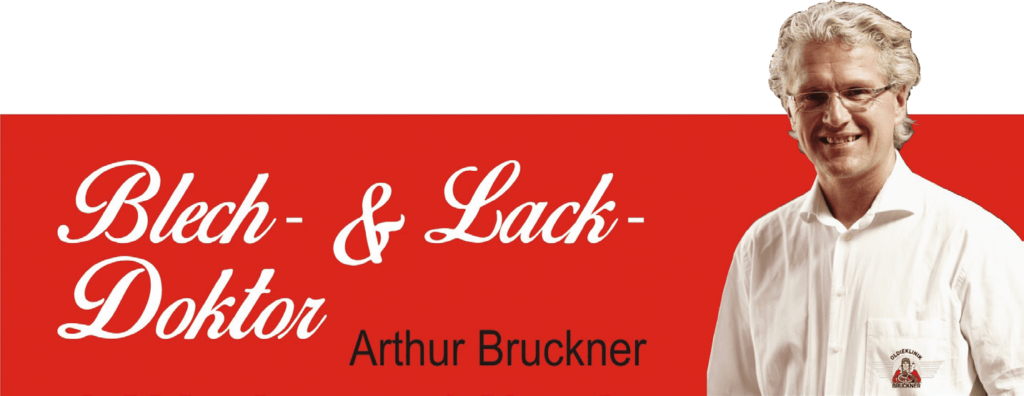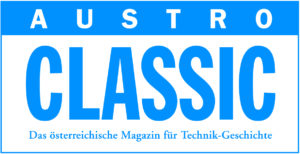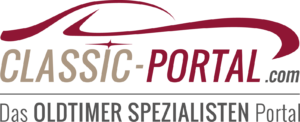
a column by Arthur Bruckner in the Austro Classic
about me …
My name is Arthur Bruckner from the Oldie Clinic in Salzburg. At the young age of 14 I shortened the base plate of my Beetle by 38 cm and screwed a GFK buggy body onto it. With this unique vehicle I unsettled the traffic at that time in the Salzburger Eichetstraße and on the surrounding meadow paths.
My professional career began in 1976 with an apprenticeship in body construction in Salzburg. In 1986 I passed the master car body construction exam and immediately restored the first classic car, a Jaguar E-Type Series 1, from scratch. In 1991 I successfully passed the master mechanic examination. With the opening of the Oldie Clinic in Salzburg, restoration was professionalized and greatly expanded.
On my topic today:
Assessment of the substance before a restoration. At the beginning of a planned restoration, the overall condition of the body and the mechanical units such as the engine, transmission, axle suspension, electrical system, etc. should be carefully checked. With today's topic, we are dealing specifically with the body and the work required for repairs. At the beginning there is an exact inspection of the body surface. For this, the vehicle should definitely be half-raised on a lifting platform. It is checked and precisely checked in the right light.
With favorable light and the right angle of view, it is possible to detect any previous accident damage. Above all, the lower edges of the door, the fender, the rear side wall and the entrance should be checked carefully for bumps or damage. Here you can immediately see welded sheet metal parts during a pre-restoration or repair. These would be particularly noticeable if they were attached by welding points with the protective gas and then covered with a kit spatula. Due to the different expansion behavior of the metals and the filler, edge sheet metal parts and welding points are evident. The method of "butt welding" in the oxy-fuel welding process or also TIG process with subsequent straightening and finishing of the welding distortion is rarely encountered.
Furthermore, before starting, the paint layer thickness should be checked with a calibrated measuring device. It is advisable to systematically note the layer thicknesses displayed and to use this to assess the quality of the previous work. The areas where the layer is thick should be checked and checked again later.
An important tip: An original coat of paint on an oldie should be max. 150–200 mq. If it has already been painted, there can be up to 300 square meters of paint and base material on the lying surfaces such as the engine hood or roof. Everything in the area from 350 mq to - as I sometimes see - up to 5 mm layer thickness shows that the repair was improper. The word restoration should no longer be used here.
Gaps and clearances When assessing the bodywork, the gaps in the doors, the bonnet and the trunk lid must be checked. Attention must also be paid to the even course and the level connection of the adjacent body parts. This can be felt with a little feeling by laying the palm of your hand and stroking over it. The locks and hinges must also be checked for wear. Locks and bolts are hard to come by and the repair of worn lock cams and wedges also requires a lot of experience and time-consuming trial and error until the door closes confidently again. If you recognize such a defect during the assessment and note it on the parts registration sheet, the locks can be repaired and repaired in good time. Finally, the vehicle body should be completely saved and the underbody examined. Watch out for compression and damage due to accidents in the front area. A simple measurement of prominent body points on the floor pan is also possible.
My tip:
I look for distinctive screw holes on the four outer corners of the floor assembly. These points can be measured crosswise with a simple tape measure. The length dimensions are also to be checked or measured here. An additional cross measurement should be carried out in the front area. The tolerance of the points should be a maximum of 2 mm, then the frame geometry is OK. If there is a deviation of more than 5 mm, the probability is very high that something has happened before.
Corrosion on the underbody
The corrosion damage occurs on the underbody, particularly in the wheel arch area and in connection with it. Any preliminary repairs found must be assessed. The longitudinal beam area in particular must be examined carefully and, if permitted, I recommend removing individual sheet metal parts. Because in the important load-bearing areas, internal metal sheets, which were seldom repaired during repairs, are usually even more visible. Also, take special care if the so-called "entry-level cover" has been welded in. This would be an indication that all inner sheet metal parts are corroded and thus have a consistency of puff pastry. Last but not least, let the car off the lift, take out all the mats in the trunk and look for further pre-repairs. Loosen the side strips in the door entry area and check under the carpet for damage and repairs.
Work according to plan ...
After completing all examination papers, I create a report for each sub-area with a precise schedule. The respective repair process is already included in this list. In the case of reinforcement plates that are not visible and difficult to see, the worst-case scenario must be assumed and the complete new production calculated. After the complete list of all necessary working hours, a time line is set together. This timeline includes the necessary dismantling work as well as the necessary repair work on the mechanical components not described here, the necessary procurement of parts and the timely ordering of the interior fittings.
Your Arthur
In my last post I reported how important it is to provide customers with comprehensive and objective information in a detailed conversation about the current condition of their classic car. This written and oral status report of all test work should always be at the beginning of every restoration. Today's post is about the dismantling work that always starts at the beginning of the full restoration of the classic car. It is important that the exact scope of work is discussed with the client and also recorded in writing before the first measures are started. This avoids later misunderstandings.
Before it really gets down to business in the workshop, I recommend precise photo documentation of the vehicle in its current condition - from 360-degree large views to numerous detailed shots. Taking photos gives you more and more an overview of the “patient”: How do the doors close? Are they clean? How do I feel when I open the hood? It is also advisable to try out all the switches on the dashboard, whereby this important test should be comprehensive - from its functionality to its current appearance. Pay special attention to the chrome and trim parts, but also to all internal components such as the window cranks, handles or levers and record the actual condition in detail on photos and on the test sheet. After that, the repair and replacement of the individual components can begin.
The mechanical units are also carefully checked in this phase of the work and replaced, repaired or stored according to the specified restoration order. In the case of the chassis and the steering parts, attention must be paid to the so-called play in the joints and the bronze bushings, and exact documentation is also recommended here. My tip: The procurement of new individual parts and the restoration of the existing components usually takes place in parallel with the work on the body.
The keyword has been heard - work on the body begins! In the first step, component by component is carefully and completely dismantled. Every step is recorded and recorded in the protocol - for example: left front manure bracket plus all screws, brackets, strips on it
and rubber parts. Each component is analyzed, evaluated and given a number, all information is recorded in the test sheet and documented with photos. Bolts must generally be recorded according to their type, length and strength. It is also necessary to assess whether the parts are original or not.
When removing, special attention must be paid to the built-in electrical wiring. When removing the cable harness, give each individual connector a number and systematically enter this in a separate list. If the vehicle has been retrofitted with additional fans or headlights, these parts must also be numbered. Take the opportunity to record the length of the existing cabling. Because when the new cable harness is manufactured, these lines are also integrated at the same time, resulting in a clean image and no “cable clutter”.
As soon as the body is completely dismantled, the next steps take place: the dismantling of the engine, drive train and all other chassis parts. Here, too, the necessary repair work must be taken into account when recording. This information should also be recorded immediately on the registration sheet. When the frame body is on the stage, a mobile trolley is made in my oldie clinic. Such an auxiliary construction has proven itself many times in the past. The brackets for the body are built with millimeter precision at those points where the axles normally take the load. When the vehicle and the temporary trolley are safely back on the ground, all doors and covers can be screwed back on and the next step in the restoration can begin: chemical stripping in a special company. You can read more about this in my article in the next Austro Classic.
With best regards from the Oldie Club in Salzburg
Your Arthur Bruckner
Organic solvents: They are used on aluminum rims, the steel frame or the engine parts. However, this method is usually not very thorough and, moreover, quite time-consuming.
Inorganic solvents: With this variant of paint removal, you have to send the vehicle to a special company. That quickly costs a few thousand euros and usually takes one to two months. When using inorganic solvents, the binder layer of the paint is attacked. At temperatures between 70 and 150 ° C the paint "disintegrates" and the adhesion of the paint layer is loosened in strips.
Thermal paint stripping: Temperatures between 380 and 450 ° C are used here. Since these high temperatures are above the gasification point of the paint, its organic components break down and turn into dust. Disadvantage of the method: The sheet also suffers from the heat and undesirable deformations of the sheet can occur.
Water jets: The process is suitable for all metallic surfaces and therefore also for aluminum. The metal to be processed is processed in a special cabin with a rotating high-pressure water jet. An enormous water pressure of 800 to 3,100 bar can be generated. The diameter of the beam can be adjusted between two and five centimeters. It cannot be prevented that water penetrates into cavities. To prevent corrosion, the water-blasted body is heated immediately afterwards. The surface is much smoother and shinier than a sandblasted one.
Cold application: This method uses dry ice - i.e. carbon dioxide with a temperature of around minus 79 ° C. Dry ice is mostly used in the form of pellets and is a non-metallic, non-mineral, inorganic, disposable abrasive. When cleaning, the layer of dirt to be removed is suddenly cooled and embrittled by the ice-cold dry ice pellets. Subsequent dry ice pellets penetrate the cracks and blast the dirt particles off the surface to be cleaned. The dry ice sublimates and increases its volume by about 700 to 1000 times. This accelerates the cleaning effect even more. A common area of application for dry ice is the removal of underbody protection, underbody cleaning and engine and transmission cleaning.
Blasting with aluminum oxide, normal corundum, glass beads, chilled cast gravel, plastic granulate or nut shells: These materials are used - depending on the area of application - always working with the appropriate pressure.
Basically: The higher the energy of the abrasive, the greater the effect on the body. For example, if you use coarse abrasive with high density in a large nozzle and high pressure, you have the shortest processing times and thus the lowest costs, but the result is an unusable, because destroyed body. Conversely, the following applies: The finer and softer the blasting media and the lower the blasting pressure and nozzle size, the more tedious - and more expensive - the blasting will be. So which method should be used? - Here it is important for the renovation professional to find a middle ground and choose a blasting agent that effectively removes paint, filler, rust, protection, glass fiber, etc. without unnecessarily damaging the body. Comparison of abrasive and non-abrasive blasting media: A blasting media is abrasive if it can scratch the material to be blasted. Sodium bicarbonate, with its Mohs hardness of 2.5–3, is not abrasive on body sheet (Mohs hardness 5), but it does on aluminum sheet (Mohs hardness 2). Non-abrasive blasting with blasting media, which are softer than the body panel, may require reworking with abrasive blasting media to remove rust (source: Surface.com page 19).
Doors, hoods and small parts must always be delivered loose to the paint stripping company. When stripping paint, many unsightly details come to light after stripping, such as a patchwork of several metal sheets, underbody protection and fiberglass filler. Or in the worst case, even roofing nails will become visible, as you can see here in our photo. These are no pleasant surprises then ... My tip: After stripping the paint, it is essential to prime immediately.
In the next part of our series I will inform you about the long-awaited start of the bodywork.
Your Arthur Bruckner


